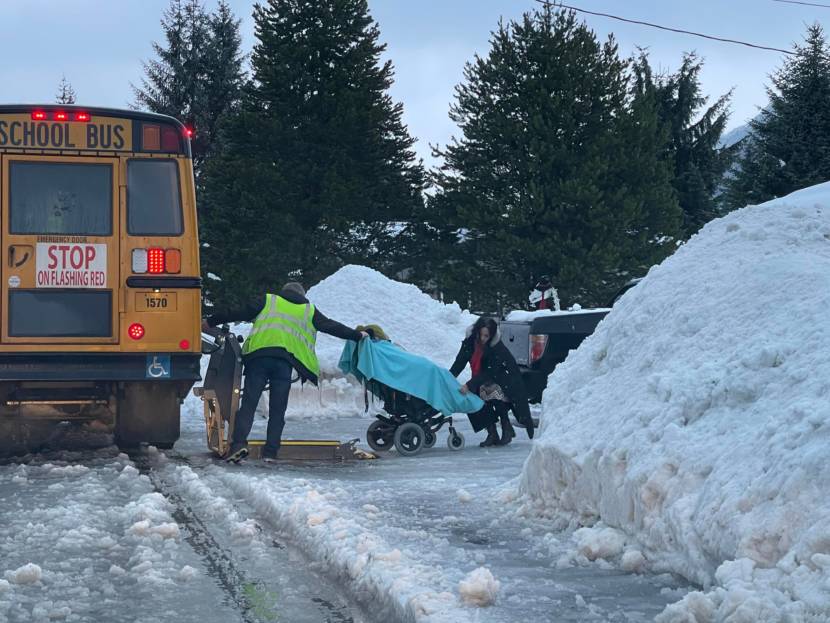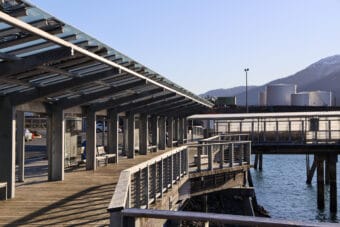
Snowplows in Juneau have had a busy year and struggled to keep up with clearing roads and sidewalks with limited resources.
After snow dumped in Juneau, it rained for days and covered many sidewalks with ice. It’s making it harder for Juneau residents who experience mobility issues to get around.
Patrick Kearney lives in the Flats neighborhood in downtown Juneau, and he walks or takes the bus to get around.
Kearney is disabled and has mobility issues because of arthritis. He doesn’t use a wheelchair or walker but still has a hard time getting around. He gets services from Southeast Alaska Independent Living, or SAIL, which is an organization that helps seniors and people with disabilities live with as much independence as they want.
This is important to Kearney. He likes to get around by himself whenever possible.
“I’m trying to be self-dependent, independent as I can,” Kearney said. “I don’t want to become totally dependent on somebody from an agency to take care of me right now.”
But lately, it’s been a challenge. He can walk through light snow but sometimes there is no sidewalk to walk on. Or if there is a sidewalk, it might be covered in ice.
“The snowplow guys come in through with their big snowplow trucks. They just clean the street off, but they pile it right up in on the sidewalk and bury cars and bus shelters and how does that help me? So the streets are clean. So I’ll walk in the street, okay. And walk against traffic,” Kearney said.

Keeping sidewalks clear is part of the Americans with Disabilities Act, which means it’s federal law. But implementing it is tricky, in part because no one organization is responsible for clearing sidewalks.
The state’s Department of Transportation and Public Facilities plows Juneau’s highways, out the road and some other high-traffic roads. The City and Borough of Juneau plows mostly neighborhoods. Whoever is responsible for the road is also responsible for plowing the sidewalks.
Businesses and property owners are responsible for clearing snow from sidewalks in front of their property. Capital Transit, a city department, is responsible for keeping bus stops clear.
“We work hard to keep those bus stops clear. It’s not always clear to, you know, the sidewalk to get to the bus,” said Katie Koester, Engineering and Public Works director for the city.
Last year, the city got new equipment to clear bus stops. But if there’s no space to put the snow nearby, it gets piled on the side of the road or sidewalk nearby until the snow can be hauled away.

Koester suggested that people who struggle with mobility use Capital Access if they are eligible for it. It’s a program that provides transportation for people with a disability who can’t make it to a bus stop. She also suggested that people walking around wear ice cleats.
Koester said plowing the roads is a priority so emergency vehicles can get around. The city doesn’t currently have a budget to plow and remove snow at the same time. So to clear the roads, the snow is sometimes piled onto the sidewalks, or onto people’s driveways.
Koester said the goal is to transition to snow removal after clearing the roads in 48 hours. During the winter storms in early January, it wasn’t always possible.
“My plea to the public is to have patience as we work to clear the streets,” Koester said. “And then my gratitude is for the work that homeowners have done keeping their storm drains clear, their fire hydrants clear, you know, shoveling the snow onto their yard from their berms.”
The berms at the end of driveways are a byproduct of clearing the streets that homeowners are responsible for clearing. Those snow berms frustrated enough homeowners in the Mendenhall Valley that one even started an online petition to stop the city from blocking private driveways. So far nearly 440 people have signed it.
This has been a struggle for the McCabe family for years. Joe and Ildiko McCabe have a daughter, Kyra Nylen, who uses a wheelchair, so they need their driveway to be wheelchair-accessible.
“Our handicapped daughter needs 24/7 care,” Joe McCabe said. “So we have health care providers for 12 hours a day and they have to get in and out of the driveway as well as Kyra has to get in and out of the driveway.”
Joe McCabe shovels the driveway for Nylen, but often has to do it multiple times because plows create berms in front of the driveway while plowing through the neighborhood. The school bus comes to pick up Nylen up at the end of the driveway.
“If there’s a berm right there, they cannot lower the ramp as well,” her mother Ildiko McCabe said. “And last year, the school bus driver actually said that even what we shoveled it, it wasn’t good enough. Like they need completely no snow, everything is gone for them to safely transfer the student.”
So in order for Nylen to ride the bus, someone has to stay home and shovel the berm first thing in the morning and then again before the bus comes back to bring her home.

Ildiko McCabe said she has tried all sorts of avenues to fix the problem. Most people tell her to hire a plow truck driver, but she said she has yet to find one who will hang out and wait to clear a berm in front of her driveway.
She called the city’s public works department and Assembly members asking for advice on what she could do. She also asked if the end of her driveway could be designated a handicap zone — which she was told was not possible.
She appreciates the work the city plows are doing and sees that the plows are understaffed and working overtime.
“But appreciating something and admitting that there’s still a problem that has no solution is, it should exist together,” Ildiko McCabe said.
After 10 years of struggling with this issue, Ildiko McCabe doesn’t know how else she can make it easier. She wishes there was some sort of process to indicate to the city that they need to have their driveway handicap-accessible.


